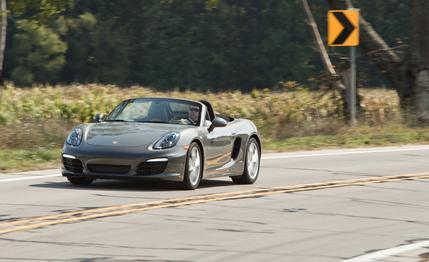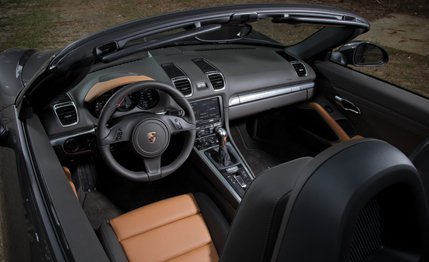
 Instrumented Test
Instrumented Test




This hasn’t happened before, so it’s worth noting: Porsche’s best car is now its entry-level one. All of Porsche’s kinesthetic achievements, all the decades of road and race engineering that have sustained the brand are now distilled in its Boxster and Boxster S, and you are free to share this information with anyone who denigrates your baby Porsche.
It feels as though all the Boxster’s constituent parts are made of equal-diameter, equal-weight, equal-length aluminum rods, each one sheathed in a quarter-inch of silicone. Every action is perfectly weighted, uncannily efficient, and supremely damped. There is no wasted motion here—not from your hand to the shifter, not from the brake to the throttle pedal, not from the structure to the suspension. Only the cup holders disappoint.


To see if our price/value thesis holds up, we tested the cheapest Boxster that Porsche had in its press fleet, a fairly stripped unit with the six-speed manual gearbox and the 2.7-liter horizontally opposed six making 265 horsepower and 206 pound-feet of torque. We did in no way miss the Yachting Blue seatbelts ($340), contrasting stitching on the steering wheel ($1025), or leather air vents ($1190) that can drive even the base Boxster deep into the pricing gap left open by the newly six-figure 911. From a starting price of $50,450, our car had only the barest of essentials—Agate/Amber two-tone leather ($640), nearly as attractive and upscale as the full-leather interior; the Premium package ($4360), including bixenon headlamps, a wind deflector, and heated and perfectly bolstered sports seats; the Infotainment package ($3860); plus some other junk like Porsche Torque Vectoring ($1320), which does something or other to brake the inside rear wheel to help the car knife through corners, and just might be more valuable than leather air vents. Grand total: $66,100. As we said, cheap.


The price is in no way justified by the numbers, except for two: 1.01 g of cornering ability and a 70-to-0 stopping distance of just 145 feet. Those capabilities are GT3-esque. Otherwise, the critical performance figures are unimpressive: 0 to 60 in 5.6 seconds, the quarter-mile in 14.0 seconds at 103 mph. Since the purpose of this story is to provide you with an instrumented test of the Boxster, we should act as if those numbers matter. But rarely have acceleration times been such a poor indicator of total performance. A last-generation Accord V-6 coupe will do the sprint nearly as quickly, and run the quarter in the same ballpark. But, good as it is, does an Accord coupe’s body right itself so instantaneously out of turns? Does its clutch pedal tell you exactly how and when to release its pressure? Is its engine’s torque this insistent? Do its brakes feel five times as powerful as its engine? Does it barely shrug its shoulders over imperfect pavement? Does it steer this well? These are rhetorical questions.
If there is a Porsche “thing,” what’s above are its core attributes. That this Porsche thing is now more completely palpable in the Boxster than almost anywhere else in the range, well, that’s a victory for the little guy—provided he has the cash. Whatever price you may put on joy, this car is cheaper than that. The Boxster is pure joy.